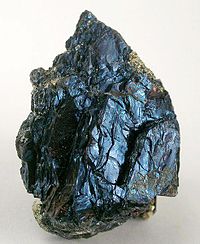
Photo from wikipedia
The unique electronic and catalytic properties emerging from low symmetry anisotropic (1D and 2D) metal chalcogenides (MCs) have generated tremendous interest for use in next generation electronics, optoelectronics, electrochemical energy… Click to show full abstract
The unique electronic and catalytic properties emerging from low symmetry anisotropic (1D and 2D) metal chalcogenides (MCs) have generated tremendous interest for use in next generation electronics, optoelectronics, electrochemical energy storage devices, and chemical sensing devices. Despite many proof-of-concept demonstrations so far, the full potential of anisotropic chalcogenides has yet to be investigated. This article provides a comprehensive overview of the recent progress made in the synthesis, mechanistic understanding, property modulation strategies, and applications of the anisotropic chalcogenides. It begins with an introduction to the basic crystal structures, and then the unique physical and chemical properties of 1D and 2D MCs. Controlled synthetic routes for anisotropic MC crystals are summarized with example advances in the solution-phase synthesis, vapor-phase synthesis, and exfoliation. Several important approaches to modulate dimensions, phases, compositions, defects, and heterostructures of anisotropic MCs are discussed. Recent significant advances in applications are highlighted for electronics, optoelectronic devices, catalysts, batteries, supercapacitors, sensing platforms, and thermoelectric devices. The article ends with prospects for future opportunities and challenges to be addressed in the academic research and practical engineering of anisotropic MCs.
Journal Title: Chemical Reviews
Year Published: 2023
Link to full text (if available)
Share on Social Media: Sign Up to like & get
recommendations!